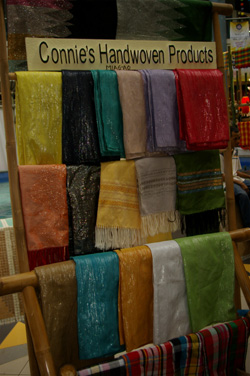
Ilo - ilo weaing, the Hablon
In Ilo-ilo, weaving patadyong is an important industry. Patadyong is wrap - around cloth worn by women. There is also Hablon, a hand woven textile made usually from cotton, abaca, or pineapple fibers. Though, nowadays, cotton is the more popular material used by Ilongos.


Time was when Iloilo was the leading center of the textile and other weaving crafts in the
Philippines. The province's weaving industry dates back to the pre-Spanish period when the Ilonggo-Bisaya at that time wove textiles from cotton, abaca, pineapple, as well as silk bartered with the Chinese.
"Hablon" is derived from the Hiligaynon word "habol", meaning to weave and, therefore, refers both to the process and the finished products. "Sinamay" is another word used to identify the industry and is taken from the Hiligaynon term "samay", which means to weave by hand. "Sinamay" products, naturally, are those that are hand-woven textile materialswhich are expensive because of the long and tedious process.
When the Spaniards arrived in Panay in the 1560s, they found the weaving industry in the island, particularly in Iloilo, already well established. They also observed that the province was producing a great quantity of cotton and other textiles for the local market. Such observation was later confirmed by other European travelers such as the Italian Giovani Careri and the German Feodor Jagor.
By the 19th century, the hablon production of Iloilo already reached a remarkable degree of development. The early growth of the handicraft weaving industry brought about considerable export of cloth to Manila and other foreign countries and resulted in the earliest recorded capital accumulation among Iloilo's emerging urban middle class (McCoy 1977).It also produced the region's first substantial urban concentrations in Jaro, Molo and Arevalo. Mostly capitalized and managed by a commercial elite of mestizos, mainly of mixed Filipino-Chinese parentage, a big number of women weavers crowded into small factories located in the town of Iloilo and its suburbs. Thus, by this time, Iloilo was already referred to as the "Textile Center" of the Philippines.
Iloilo's hablon industry was concentrated in Jaro, Molo, Arevalo and Mandurriao, but other towns like Miag-ao, Tigbauan, Sta. Barbara and Janiuay were also noted for weaving, especially the "patadyong", the common wear of women at that time. Indicative of the remarkable development of the hablon industry was the observation made in 1857 by Nicholas Loney, British vice-consul in Iloilo, of the festive market fairs held at the different towns where native-made clothes were sold in abundance. He also noted the great number of looms in the province at that time, about 60,000 according to him (Loney to Farren 1857).
Loney's observations were similarly noted by others,such as Tomas de Comyn, Gregorio Sanciano and John Bowring.
The most valuable of the native manufactured textiles was "sinamay" made of pure "pina" or mixed with silk imported from China. The coarser fabrics, on the other hand, were woven from cotton, abaca and maguey fibers. The greater part of the "pina" and mixed "pina", silk and cotton fabrics were used for shirts for the men and short jackets or blouses for women. the prices varied considerably according to the fineness or coarseness of the texture and the greater or lesser amount of mixture. It also depended on the amount of embroidery work found on the cloth. Some pieces for the men's shirts cost as much as $7 in 1857. Their value when elaborately embroidered increased up to $50 or even $100 when sold in Manila. The inferior ones cost $0.50 to $2 per piece of about four yards each (Ibid).
Textile goods were the chief exports of Iloilo from the second half of the 18th century up to about the 1870s. In the 1850s, woven materials constituted more than 50% of the total value of the province's exports. By the early 1860s, the value of exports from the textile industry was estimated to be nearly a million dollars (Loney to Farren 1861).
Towards the 1880s, however, as a result of Iloilo becoming a sugar entrepot in Western Visayas with the opening of its port to international trade, the weaving industry lost its primary importance. Because of the attraction of the sugar industry, many of the Ilonggo enrepreneurs shifted their interests and capital from weaving to sugar production. Also, cheaper machine-made English cotton goodesentered the Philippine market and competed heavily with the local textile materials, resulting to the decline of the hablon industry. Furthermore, areas that were formerly devoted to the cultivation of cotton, abaca and pineapple were transformed into sugarcane plantations, thereby depriving the local weaving industry of raw materials. Moreover, the number of young female weavers dwindled due totwo reasons: the rising interest in formal schooling, and the availability of jobs as sales girls and domestic helpers in the capital town of Iloilo and its suburbs. Finally, not to be ignored is the fact that the mass exodus of people from Iloilo to Negros Island, attracted by the promise of the sugar industry, included a good number of weavers and their departure depleted the number of those engaged in the craft.
Source: http://arevalohandwovenproducts.weebly.com/hablon-in-iloilo.html
No comments:
Post a Comment